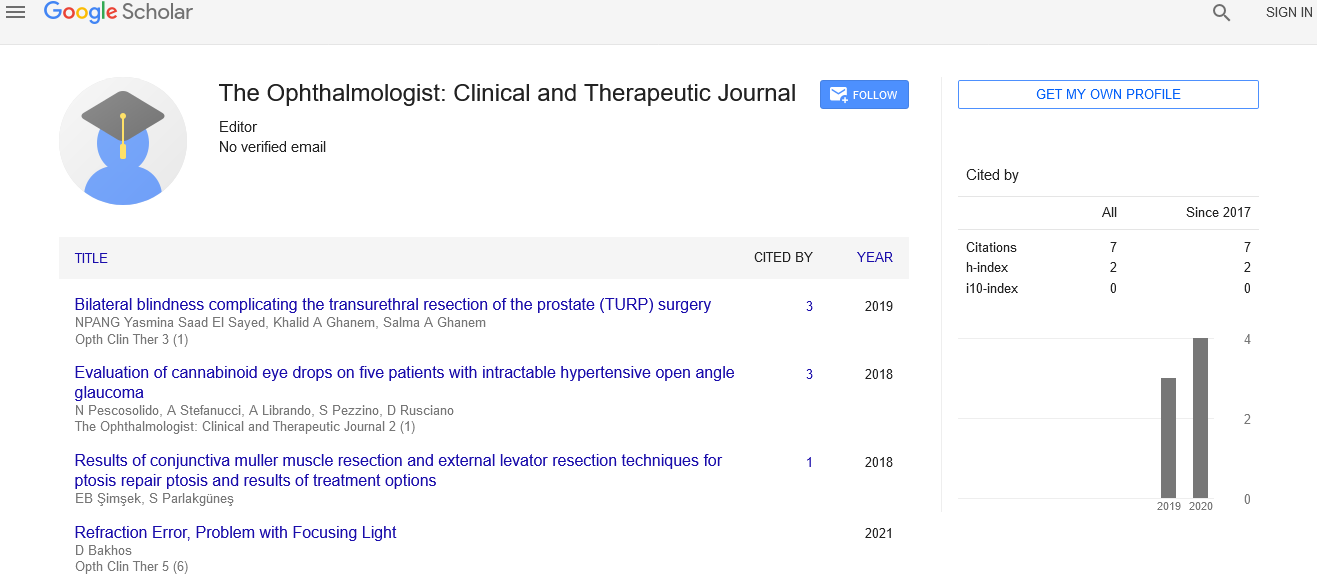Prevalence of glaucoma
Received: 26-Oct-2020 Accepted Date: Nov 11, 2020; Published: 19-Nov-2020
Citation: Klettt D. Prevalence of glaucoma. Opth Clin Ther. 2020;4(3):11.
This open-access article is distributed under the terms of the Creative Commons Attribution Non-Commercial License (CC BY-NC) (http://creativecommons.org/licenses/by-nc/4.0/), which permits reuse, distribution and reproduction of the article, provided that the original work is properly cited and the reuse is restricted to noncommercial purposes. For commercial reuse, contact reprints@pulsus.com
Introduction
Eyes are the major organs of visual system. They provide vision for all living beings and photo response functions which are independent of vision. Glaucoma is a condition of group of diseases which effect eye and worsens eye’s optic nerve which supplies information from eyes to brain. It may also lead to blindness when severity increases.
Glaucoma sometimes caused due to abnormal high pressure in eyes. As the increased pressure inside the eye can erode your optic nerve tissue and can lead to blindness or vision loss. The early detection of the disease can help in preventing the vision loss. Glaucoma is commonly called as “silent thief of sight”.
The disease can affect both the eyes, in which one can be affected more than the other. Many types of glaucoma do not include any symptoms. It can affect any age group people but more commonly causes blindness in people over 60 years of age.
Occurrence of Glaucoma
The fluid which is present inside the eye is called as aqueous humor which usually flows out of eye like a channel. If any kind of blockage occurs in this channel, the liquid builds up. The reason behind the blockage is not yet found by the experts [1].
There are many kinds of glaucoma. But the major forms include: “Primary open-angle glaucoma” and “Angle-closure glaucoma” which is also called as “closed-angle glaucoma” or “narrow-angle glaucoma”. Open-angle which is also known as chronic glaucoma has no signs or symptoms except gradual vision loss. This loss can be so slow by which your vision can suffer irreparable damage before any other signs may appear. This has been considered as the most common type of glaucoma [2].
The sudden blockage of aqueous humor results in the rapid buildup of fluid and cause a quick, severe and painful increase in the ocular pressure. Angle-closure glaucoma is always an emergency situation. The risk factors of glaucoma includes: age, ethnicity, eye problems, family history, medical history, eye surgery, eye injury, myopia, high eye pressure, having high blood pressure, heart disease, diabetes, sickle cell anemia and other eye related diseases and disorders [3].
The treatment of Glaucoma consists of improving the flow of fluid from the eye or reducing the production or it can be both. The primary treatment of glaucoma includes eye drops through which the fluid blockage gets cleared. The eye drops such as cholinergic agents, prostaglandin analogues, beta blockers and carbonic anhydrase inhibitors can be used. The side effects of eyedrops may include stinging, eyelash growth, redness, difficulty breathing, change in eye color and occasionally retinal detachments. They may reduce while intake occurs during meals [4].
There is also a risk of finding rashes on skin, weight loss, stomach ache, fatigue, impotence etc. The surgery procedures for the glaucoma disease include Trabeculoplasty, Filtering surgery or viscocanalostomy and Drainage implant or aqueous shunt implant.
REFERENCES
- Merritt JC, Perry DD, Russell DN, et al. Topical delta 9- tetrahydrocannabinol and aqueous dynamics in glaucoma. J Clin Pharmacol. 1981; 21(8-9):467S-1S.
- Baroody M, Holds JB, Vick VL. Advances in the diagnosis and treatment of ptosis. Curr Opin Ophthalmol. 2005; 16(6):351-5.
- Pateras E. Advance research in the field of optics and optometry. Opth Clin Ther. 2017; 1:6.
- Iwase A, Suzuki Y, Araie M, et al. The prevalence of primary openangle glaucoma in japanese: the tajimi study. Ophthalmology. 2004; 111(9):1641-48.





